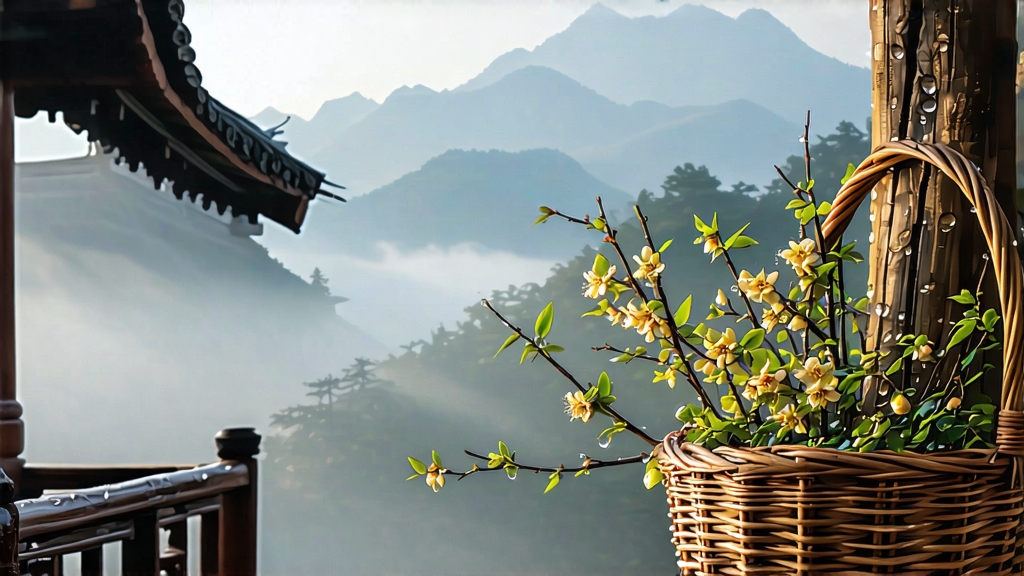
Tucked high on the northern rim of the Sichuan Basin, where the Min River cuts through a stair-case of cloud-veiled terraces, lies Meng Ding Mountain—Meng Shan for short. For twelve centuries its name has been whispered in the same breath as the most coveted teas of China, yet beyond the Middle Kingdom its fame has been eclipsed by green Long Jing and black Qi Men. Among the handful of yellow teas that survive today, none carries the weight of history more gracefully than Meng Ding Huang Ya: the “yellow bud from the summit of Meng.” To meet it is to taste a vanished courtly China, a tea that was once measured in gold and carried by frost-bit horses to the gates of Chang-an.
History: from elixir to exile
Buddhist monk Wu Li Zhen is said to have planted the first seven bushes on Meng Ding’s summit around 53 BCE, making them the earliest known cultivated tea trees in the world. By the Tang dynasty (618-907) the tea was already “tribute grade,” and the Song emperor Huizong—himself a gifted calligrapher—decreed that only buds picked before the Qingming festival could enter the palace. Caravans descended the narrow plank roads of Sichuan, each bamboo tube sealed with red wax and stamped with the governor’s seal. When the Ming court shifted its taste to newly fashionable loose-leaf greens, yellow tea fell out of favor; the slow “sealed yellowing” process was deemed too costly. Production all but ceased until 1959, when a state-sponsored revival team combed the mountain for elderly artisans who still remembered the old sweat-box technique. Today fewer than 200 families continue the full traditional craft, and authentic Meng Ding Huang Ya accounts for perhaps 0.02 % of China’s annual tea output.
Micro-terroir: why the mountain makes yellow possible
Meng Ding is not a single peak but a saw-toothed ridge rising from 800 m to 1 456 m within 5 km. The northern flank catches the cold down-drafts of the Tibetan Plateau while the southern face drinks the humid breath of the Sichuan Basin. The result is a 280-day fog season that filters sunlight into a soft, diffused glow—ideal for accumulating the soluble amino acids that give yellow tea its hallmark sweetness. Soils are Devonian sandstone leached by constant mist, yielding a sandy loam so porous that tea roots can descend two metres, mining minerals that translate into a silky, stone-fruit cup. Finally, the mountain’s wild magnolia and osmanthus forests inoculate the air with airborne esters that settle on the leaf surface, adding a covert floral layer often mistaken for scenting.
Plucking: one bud, one leaf, one breath
The harvest window opens ten days before Qingming when the plateau nights still drop to 8 °C. Workers climb before dawn so that each bud is picked while turgid with overnight moisture. The standard is “one bud with one unopened leaf” no longer than 2.5 cm, a specification locals call que-she, “sparrow tongue.” A seasoned plucker fills only 250 g per hour; 60 000 such sets yield a single kilo of finished tea. The leaf must reach the village workshop within two hours—any longer and enzymatic activity will veer unpredictably during yellowing.
Craft: the art of letting the leaf suffocate gently
Meng Ding Huang Ya is not merely green tea with an extra step; it is a choreography of heat, moisture and oxygen deprivation that borders on alchemy.
-
Sha Qing (kill-green)
Leaf is tossed into a bamboo-drummed wok set to 160 °C. The motion is a figure-eight, wrists pivoting so that every bud kisses the metal for less than three seconds. In four minutes the leaf temperature spikes to 85 °C, deactivating polyphenol oxidase while preserving the yellowing precursors. -
Re-wrapped Sweating
Immediately after kill-green the hot leaf is piled into linen sacks and buried in a chest of toasted rice straw. The straw acts as a thermal capacitor, holding the mass at 38–40 °C for 40 minutes. During this enclosed “suffocation” chlorophyll degrades into pheophytin, catechins dimerise into theaflavins, and a faint maillard note of toasted sesame emerges. -
First drying on low charcoal
The leaf is spread on horse-h